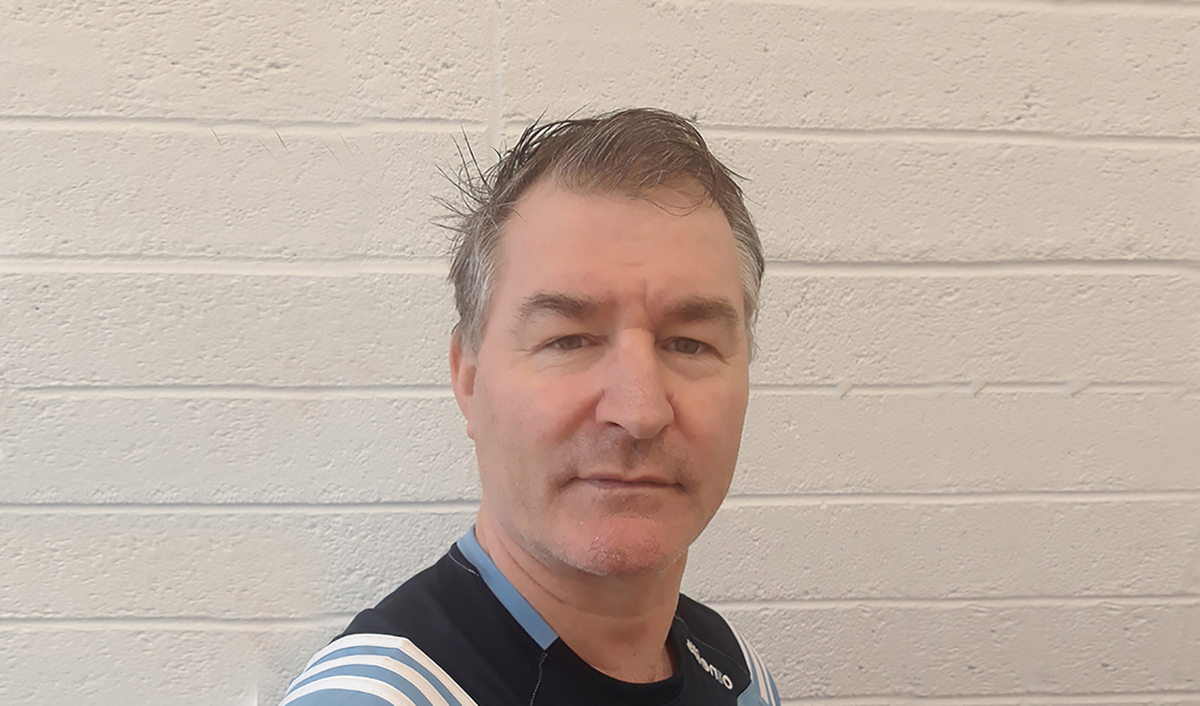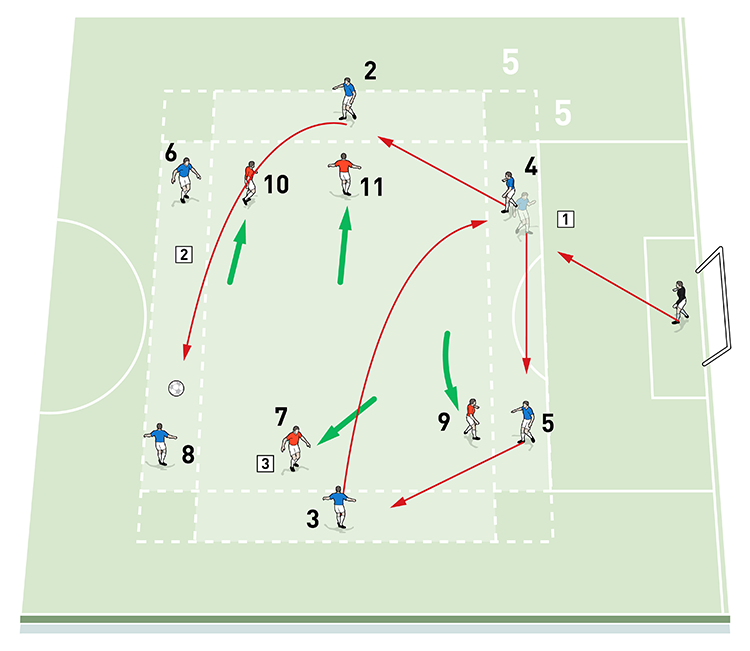Possession and ball movement
This session is all about maintaining possession and encouraging ball movement within a team’s offensive organisation.

| Area | Up to full pitch |
| Equipment | Balls, bibs, cones, 2 full size goals |
| No. of Players | Up to 20 players + 2 goalkeepers |
| Session Time |
Positional balance practice 1: 20mins, Positional balance practice 2: 20mins, 11v11 game: 44mins |
This session is all about maintaining possession and encouraging ball movement within a team’s offensive organisation.
It teaches players to circulate the ball better, in order to disorganise and unbalance opponents, so the team can take advantage of the spaces behind the defensive blocks of the opposition.
I would run this session once or twice a week as a sub principle of a plan for offensive organisation. It will help teams to play out from the back by keeping possession and it teaches the players to communicate better during the build-up play. This will help them to make better decisions – and as a consequence, they will achieve a better execution of these decisions within their football actions.
POSITIONAL BALANCE PRACTICE 1
This activity works on the team’s positional balance when in possession. We set up on just under half a pitch with a goal and a goalkeeper at one end and a central zone surrounded by five-yard channels marked as shown between the 18-yard line and the centre circle.
We’re using 10 outfield players for this activity. The blue possession team of six is made up of a back four and two central midfielders, while the red pressing team of four is made up of two wingers, an attacking midfielder and a centre forward.
The blue possession team plays in the channels around the edge of the central area in the specific positions indicated. They are locked in their channels when in possession but they can come out of the channels when they lose the ball.
Play starts with a pass out from the goalkeeper to the blue central defenders and the blues must then pass to keep possession without leaving their nominated channels, as shown [1a]. If they complete 10 consecutive passes, they score a point.
1a

2. When they are in possession, the blues are locked in their specific channels around the edge of the central area
3. The reds press the blue passers and try to win the ball, but they must remain in the central area when out of possession
The reds press the passers and try to win the ball, but they must remain in the central area and not enter the channels. If they manage to exert enough pressure to intercept the ball from the blues, they are then free to attack the goal and try to score, as shown [1b].
1b

2. On losing possession, the blues can leave their channels and attempt to win the ball back or prevent the reds scoring
3. If the reds score or if the blues win the ball back, the players must reset and the practice starts again
On losing possession, the blues are no longer restricted to their channels and may attempt to recover to defend by either winning the ball back or by preventing a goal from being scored.
If the reds manage to score a goal or if the blue team wins the ball back, the players must reset and the practice starts again with a pass out from the keeper.
POSITIONAL BALANCE PRACTICE 2
We set up on a full pitch with a goal and a goalkeeper at each end. We mark a 25x10 yard box on each side of the pitch, with a 15x50 yard central zone between them as shown. We’re using 20 outfield players split into two full teams of 11 including keepers.
For the blue team, the wing backs are locked into the wide boxes and the two defensive midfielders are locked in the central zone until the ball crosses into the opposition half of the pitch.
The reds are restricted to five players in their attacking midfield and only these five players are allowed in the opposition’s half of the pitch.
Play starts with a pass out by the blue keeper to one of the defenders and the blues build up play from the back, trying to work the ball to the attacking midfielders in the opposition’s half and create a goal scoring chance with the help of their wing backs, who are released from their boxes as soon as the ball crosses the halfway line, as shown [2a].
2a

2. For the reds, only four attacking midfielders and the centre forward are allowed in the opposition’s half
3. The blue wing backs are locked into the wide boxes and the two blue defensive midfielders are locked in the central zone until the ball crosses the halfway line. Then they are all released to join the attack
4. The reds defend against the attack and try to gain possession
The two blue wingers, the blue attacking midfielder and the blue centre forward must remain in the opposition half of the pitch until their team loses possession. The reds defend against the attack and try to gain possession and counter. However, as soon as the blue team loses possession, all of its players may abandon their restricted zones and recover to defend against the red attack, as shown [2b].
2b

2. For the blues, both wingers, their attacking midfielder and their centre forward must remain in the opposition half while their team is in possession
3. As soon as the blue team loses possession, all of its players may leave their restricted zones and can recover to defend against the red attack
4. If the ball goes dead, or if the blues win the ball back after losing possession, all players must reset and return to their original positions to restart play from the blue keeper
When a goal is scored or if the blue team wins the ball back after losing possession, or any time there is a stoppage, all players must reset and return to their original positions to restart the activity.
COACHING POINTS
What are the key things to look for?
The team’s possession and ball movement is the what of this exercise and the players have to align their individual intentions (the how) to this principle.
We want to see an improvement in team tactics, game insights and football technique by improving their communication, their decision making and the execution of these decisions.
While the main aim of this training session is to disorganise and unbalance the opponent to take advantage of the spaces behind the defensive lines, the sub principles include: achieving a good positional balance; work on the distribution of the goalkeeper; passing the ball to attract opponents; playing direct; and offensive unity.
What are the typical mistakes players might make and how do I avoid them?
Players can sometimes miscommunicate when aligning the tactical principles. Another typical mistake occurs when players internally focus on the basic techniques of passing rather than thinking about the team’s tactics.
How would I put this in a game situation?
The activities shown here explain how to break the training session down into sub principles of the team intentions.
To get the players to put what they’ve learnt into a game situation, I would remove all cones and zones and play 11 v11 games between the two penalty boxes [not shown], emphasising the above tactical principles. We would end the session by playing four games of 11 minutes each.
Editor's Picks
Attacking transitions
Deep runs in the final third
Using the goalkeeper in build-up play
Intensive boxes drill with goals
Penetrating the final third
Creating and finishing
My philosophy
Pressing initiation
Compact team movement
Coaches' Testimonials

Alan Pardew

Arsène Wenger

Brendan Rodgers

Carlos Carvalhal

José Mourinho

Jürgen Klopp

Pep Guardiola

Roy Hodgson

Sir Alex Ferguson

Steven Gerrard
Coaches' Testimonials

Gerald Kearney, Downtown Las Vegas Soccer Club

Paul Butler, Florida, USA

Rick Shields, Springboro, USA

Tony Green, Pierrefonds Titans, Quebec, Canada
Join the world's leading coaches and managers and discover for yourself one of the best kept secrets in coaching. No other training tool on the planet is written or read by the calibre of names you’ll find in Elite Soccer.
In a recent survey 92% of subscribers said Elite Soccer makes them more confident, 89% said it makes them a more effective coach and 91% said it makes them more inspired.
Get Monthly Inspiration
All the latest techniques and approaches
Since 2010 Elite Soccer has given subscribers exclusive insight into the training ground practices of the world’s best coaches. Published in partnership with the League Managers Association we have unparalleled access to the leading lights in the English leagues, as well as a host of international managers.
Elite Soccer exclusively features sessions written by the coaches themselves. There are no observed sessions and no sessions “in the style of”, just first-hand advice delivered direct to you from the coach.









